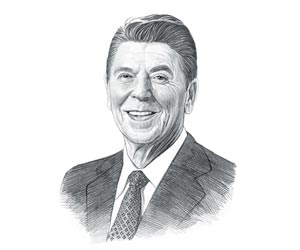|
|
|
|
|
Reaganomics encompassed a series of disparate economic policies and legislation aimed at decreasing the growth in government spending, reducing taxes, easing economic regulation and promoting unrestricted free-market activity. The economic theory behind Reaganomics combined supply-side economics with monetarism and by 1983 the U.S. economy finally began to recover from the period of recession known as 'Stagflation'. Facts about
Reaganomics The economic theory behind Reaganomics was called supply-side or trickle-down economics with monetarism. The economic theory behind supply-side economics was to boost production, meaning the "supply" of goods and services, to encourage economic growth. The theory behind monetarism was to control the supply of money as the chief method of stabilizing the economy by providing tax cuts for investors creating incentives to save and invest, producing economic benefits that would "trickle down" into the overall economy. The term "Reaganomics" was coined by Paul Harvey, an American radio broadcaster for the ABC Radio Networks, and a supporter of Ronald Reagan. The economic phenomenon of the 1970's, referred to as 'Stagflation', was characterized by high inflation and stagnation. Inflation meant that Americans were getting less for their money than they used to be able to get. Economic stagnation had resulted in a prolonged period of slow economic growth, accompanied by high unemployment. The Nixon, Ford and Carter administrations introduced numerous and often conflicting economic policies to combat Stagflation, but these had all failed. When the conservative President Ronald Reagan was elected in 1981 he was faced with the onerous task of fixing the U.S. economy. He needed to succeed where his predecessors had failed. In his 1981 Program for Economic Recovery, President Reagan had four major objectives:
The effect of the four major changes in the 1981 economic policy were expected to:
President Reagan issued his first executive order 12287 for the Decontrol of Crude Oil and Refined Petroleum Products to address gasoline rationing. This eliminated price controls on oil and natural gas. Production soared, and the price of oil declined by more than 50% releasing money which helped economic recovery. Deregulation: Reagan began to slowly reduce economic regulation. The flagging automobile industry was boosted when the National Highway Traffic and Safety Administration reduced its demand for higher fuel efficiency. Deregulation: The government decided not to regulate the new cable TV industry. Plans to regulate long-distance telephone services, interstate bus services and ocean shipping industries were also abandoned. Deregulation: The airline industry was also deregulated which resulted in cheaper air fares and the establishment of new airlines. Deregulation: Controversial policies were implemented in relation to the environment as public lands were released for mining, timber and oil industries and regulations were eased on pollution control. Deregulation: The scope of the antitrust laws was reduced and banks were allowed to invest in a wider set of assets. U.S. federal tax legislation: The Economic Recovery Tax Act of 1981 (ERTA) was signed on August 13, 1981 and contained numerous provisions intended to help individuals and businesses in the Reaganomics tax plan. Cutting Taxes: Income taxes on the wealthiest Americans were cut from 70% to 50% to 28% during his two terms in office. The corporate income tax rate was reduced from 48% to 34%. Virtually all the poor were exempted from federal income taxes, by almost doubling personal exemptions. Improvements to highways and bridges were essential to the U.S. transportation system. The Highway Revenue Act of 1982 January 6, 1983, temporarily increased the United States gasoline excise tax from 4 cents to 9 cents through September 30, 1988 to support improvements to highways and bridges. Investment Incentives: The tax cuts had large investment incentives in the form of accelerated depreciation, that were gradually reduced in each subsequent year through to 1985 Off Setting Tax Cuts: To off set the tax cuts a small increase in Social Security tax rates were made and some excise tax rates were increased. Tax Legislation: The Tax Equity and Fiscal Responsibility Act of 1982 (TEFRA) was passed to increase tax revenue by eliminating various taxation loopholes and introducing tougher enforcement procedures in collecting taxes. Tax Legislation: Congress later passed the Tax Reform Act of 1986 (TRA) on October 22, 1986 to simplify the income tax code and eliminate many tax shelters. Cutting Social Programs: The cuts in taxes resulted in the government receiving less money and would increase the budget deficit. This problem was addressed by making cuts to some welfare benefits and social programs. school lunch programs were cut back as were food stamps. Reductions were also made to unemployment compensation, Medicare payments, housing subsidies and student loans. By 1983 the U.S. economy finally began to recover and the economic crisis known as Stagflation came to an end. The biggest failure of Reaganomics was the inability to reduce the federal deficit and control spending. During the whole period of Reaganomics and its new economic polices President Reagan had made the decision to build up the US military. This, together with the tax cuts, was seen by Reagan as more important than balancing the budget and as a result the annual budget deficit increased from $80 billion to over $200 billion. The adoption of the economic policies known as Reaganomics resulted in many successes. By 1988 productivity had increased by 3.8%. The unemployment rate had fallen from 7% in 1980 to 5.4% in 1988. 5 million new businesses and 20 million jobs were created. The inflation rate fell from 10.4% percent in 1980 to 4.2% in 1988. |
| US American History |
| 1945-1993: Cold War Era |
|
|
|
|
|
First Published2016-04-19 | |||
|
Updated 2018-01-01 |
Publisher
Siteseen Limited
| ||
|
|

